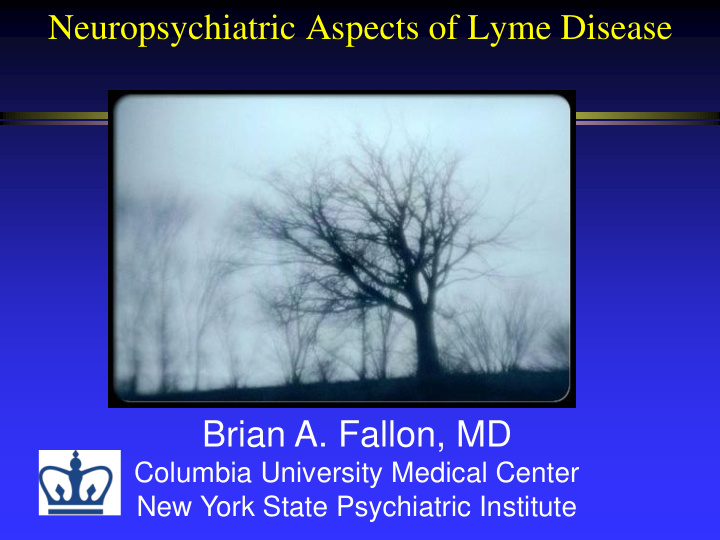



Neuropsychiatric Aspects of Lyme Disease Brian A. Fallon, MD Columbia University Medical Center New York State Psychiatric Institute
CLP 2019 Disclosure: Brian A. Fallon, MD Dr. Fallon has received funding for research in Lyme Disease and related areas from the Cohen Foundation, the NIH NIAID, the Global Lyme Alliance, the FDC Foundation, and an anonymous foundation. Profits from sales of the book mentioned in the presentation are donated to research in infectious diseases and psychiatry at Columbia University. With respect to the following presentation, there has been no relevant (direct or indirect) financial relationship between Dr. Fallon (and/or spouse/partner) and any for-profit company which could be considered a conflict of interest.
Signs of Lyme Disease Early: Erythema Migrans Rash – Only 20% of time is it a bull’s eye Early or Late Disseminated: – Dermatologic: multiple EMs – Neurologic Cranial nerves Peripheral nerves Central Nervous System – Arthritis (swelling or synovitis) – Cardiac (heart block, carditis)
“Bb in the Nervous System: The New Great Imitator” Case 1: Anorexia/OCD Pachner A. Annals of NY Academy of Sciences, 1988
Case 1: Dr. Mary 42 year old physician – During the 8 weeks after a tick bite, she developed fatigue, myalgias, cognitive problems. Lyme tests were positive. Treated with doxy…90% better. – Relapsed after 4 months – treated again – better again. – Relapsed a 3 rd time, but then treated with azithromycin – this led to a sustained improvement.
Case 1 Comments 20% of patients with LD do not see a rash Cognitive problems occur – “brain fog” 10-20% develop recurrent symptoms after initial treatment – “Post - treatment Lyme Disease Syndrome” – “Chronic Lyme Disease”
PTLS vs Chronic Lyme Disease Terms make a difference PTLS requires well-documented prior Lyme disease, persistent Sx & impairment. Immune biomarkers of PTLS: – anti-neuronal Ab – comparable to SLE – Endothelial cell growth factor antibody – IL6 & expression of IF alpha – Chemokine CCL 19 – CSF Complement cascade proteins
Functional Neuroimaging Brain SPECT – May show moderate to severe heterogeneous hypoperfusion, but this is non-specific Brain FDG PET & O-15 PET – Temporal & parietal hypometabolism The patient group showed a diminished ability to enhance blood flow compared to controls (8.2% for patients vs 28.1% for controls, p<.02) Fallon et al, JAMA Psychiatry 2009
Repeated Treatment significantly reduced fatigue in two RCTs
Borrelia persist despite antibiotics. This has been shown in many species. Often with minimal or No Disease Slide courtesy of Stephen Barthold, UC Davis
Xenodiagnosis – an old technique to detect spirochetes in mice & humans When blood and tissue sampling fail to detect Bb spirochetes, ticks come to the rescue – attracting spirochetal DNA. 1 of 9 PTLS tested positive by (Marques, Hu, et al, CID, 2014) xenodiagnosis
Case 2. Bill. 27 year old man with intermittent paranoia Paranoia…months later encephalopathic ICU: – CSF & serum + for Bb antibodies & WBC – IV Ceftriaxone Tx – 80% better, discharged 3 weeks later – joint/cognition deteriorates Hosp: retreated with IV Ceftriaxone – no benefit – Conclusion – “This must be a psych problem.” Minocycline eventually leads to marked improvement
Case 2. Comments Psychiatric sx may be presenting feature Cognitive problems are usually mild- moderate – but rarely can be severe Relapse after good response can occur While IV ceftriaxone is excellent for neurologic Lyme disease, in some cases other antibiotics may also be useful.
Diagnostic Evaluation Blood Tests – C6 Peptide ELISA – Two-tier assay: ELISA & Western blot Spinal Fluid: remember to send serum collected on same day Cognitive Testing: especially verbal fluency Other: Neuroimaging, Nerve Conduction Studies, Small Nerve fiber Skin Biopsy
Serologic Tests ELISA: Whole Cell Sonicate, C6 Peptide, VlsE – Sensitivity: 30-50% early LD, 70-90% neurologic LD Western blot – IgM (meaningful in first 4-6 weeks after infection) This can stay positive for many months, long after treatment resolved symptoms Some patients do not seroswitch from IgM to IgG – IgG (5 bands meet CDC criteria, but 4 are highly suspicious) If seronegative but clinical profile is strong , look for early antibiotics as these may have abrogated Ab response
Standard Blood tests are helpful but not definitive Ab response – can stay positive for years – Do not clarify whether infection resolves False positives & false negatives occur – False positives may occur with ELISA and IgM WB, esp after mono infection. IgG WB has non-specific antigens (e.g.41, 66)
A good test would be positive when the infection is present & negative when the infection has resolved Ixodus species -Ricinus (EU) -Scapularis & Pacificus (USA) Borrelia sensu lato -B. garinii (EU) Arthritis (Rheumatologic) -B. afzelii (EU) Neuroborreliosis Lyme -B. burgdorferi (EU/USA) ACA (Skin inflammation) Borreliosis Post-treatment Lyme Recovery 17 Syndrome
Cerebrospinal Fluid Testing for Neuroborreliosis CSF Findings – Intrathecal Antibody production (paired serum & CSF) – May see elevated protein & WBC – Oligoclonal bands are uncommon – PCR & Culture are insensitive – CXCLXIII – sensitive marker of active NB Spinal fluid may test positive for Bb antibodies even if serum is negative Experimental assays suggest CSF may be falsely negative in 20% of cases.
Common Tick-borne Coinfections Borrelia miyamotoi Babesia microti Ehrlichia Anaplasma
Which cognitive domains differentiate memory impaired patients? PTLS vs Depression Demographically-adjusted aggregate domain Z-scores for neuropsychological measures in memory impaired patient groups and healthy comparison subjects. (Keilp, 2019) Non-patient: yellow Depressed: blue PTLS: red Verbal Fluency is worse in PTLS (red) while Attention is worse in Depression (blue)
Other Treatment approaches to consider if symptoms persist Immune modulatory therapy (e.g, IVIg) Pharmacotherapy for pain, sleep, mood Brain Stimulation (eg, TMS) Psychotherapy
Website: www.columbia-lyme.org Conquering Lyme Disease Written for physicians & educated public. 421 pages Columbia Press: Use code CUP30 for 30% off cost Favorable reviews – Nature; Lancet Infectious Disease All Proceeds support research www.columbia-lyme.org
Recommend
More recommend